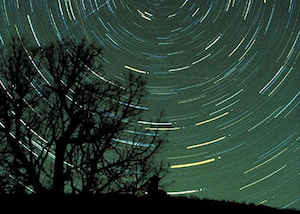Geminid meteor shower 2011
Gemenid meteor shower watchers can’t figure out where all the material in the event comes from. Asteroid 3200 Phaethon, the apparent source of the Gemenid meteor shower, doesn’t seem to shed enough rock and dust to account for the shower’s intensity.
Roll up, roll up for the mystery (meteor) shower – the Geminids.
By now you’ve probably heard that tonight’s the night for what is arguably one of the most spectacular meteor showers of the year, the Geminids.
The shower earns its name from its apparent point of origin, or radiant, in the constellation Gemini.
But where many meteor showers represent Earth’s encounter with dust from a comet, the Geminids appear to have an odd duck of a source – an asteroid that some now call a rock comet.
And it’s not clear from recent observations whether the object, known as 3200 Phaethon, is kicking off enough material to account for the intensity of the meteor shower Earth encounters.
A team of astronomers identified the debris gap in a paper published in the Astronomical Journal in Nov. 2010. And researchers are still puzzling over it.
The 2011 Geminid meteor shower peaks on the night of December 13-14, and despite the glare of a nearly-full moon, it might be a good show.
“Observers with clear skies could see as many as 40 Geminids per hour” – predicts Bill Cooke of the NASA Meteoroid Environment Office.
“Our all-sky network of meteor cameras has captured several early Geminid fireballs” – Cooke said. “They were so bright, we could see them despite the moonlight.”
An early Geminid fireball recorded on December 11 by a NASA meteor network camera in Tennessee.
The best time to look is between 10 p.m. local time on Tuesday, December 13, and sunrise on Wednesday, December 14.
Geminids, which spray out of the constellation Gemini, can appear anywhere in the sky.
“Dress warmly and look up” – says Cooke. “It’s that simple.”
The source of the Geminids is near-Earth asteroid 3200 Phaethon. Most meteor showers come from comets, so having an asteroid as a parent makes the Geminids a bit of an oddball.
“This is the thing I love most about Geminids” – says Cooke. “They’re so strange.”
Every year in mid-December, Earth runs through a trail of dusty debris that litters the orbit of 3200 Phaethon. Comets vaporizing in hot sunlight naturally produce such debris trails, but rocky asteroids like 3200 Phaethon do not. At least they’re not supposed to. The incongruity has baffled researchers since 1983 when 3200 Phaethon was discovered by NASA’s IRAS satellite.
http://www.youtube.com/watch?v=f5e5dQkFtnk
Just before the moon rises on Dec. 13, and just after it sets on the 14th, and even during the hours between, the celestially inclined are invited to train their eyes on the skies for the year’s last spectacular show—the Geminid meteor shower, which occurs annually in mid-December.
The past few months have brought a southern visit from the Aurora Borealis, an asteroid and even another rain of shooting stars, the Orionids. But unlike the Orionids, which are thought to be debris from Halley’s Comet, the Geminids spring from a plain old rock—another asteroid, to be exact.
No Native American name for this one, though. The source of the Geminids is a hunk of flying rock named 3200 Phaethon, according to NASA. The U.S. space agency said in a release that since most meteor showers spring from comets, the Geminids’ asteroid parentage makes them “a bit of an oddball.” It also makes for a slightly more spectacular show, with streaks of color possible, and slightly longer visibility given that 3200 Phaethon’s shards (most are the size of sand grains) streak slightly slower across the sky than their comet-generated counterparts. And yes, those fireballs, some of them even exploding.
Even the light of the recently eclipsed moon bathing much of North America can’t obscure the shooting stars. At least some of the Geminids will be spottable despite the sky’s bright light – NASA said.
For stargazers in Mount Gilead, North Carolina, the Town Creek Indian Mound archaeology and cultural preservation site is holding an Astronomy Night. People are encouraged to bring blankets and lawn chairs, and enjoy the show.
Best viewing will be around 10 p.m. local time wherever you are, NASA said, though astronomer Geza Gyuk at the Adler Planetarium in Chicago told National Geographic that around 9 p.m. would be good as well. The shower emanates from the constellation Gemini, which will be low on the horizon at that hour. Night owls can catch them a few hours later, at around 2 a.m. the morning of December 14, when they will be high overhead, Gyuk told the magazine.
“Observers with clear skies could see as many as 40 Geminids per hour” – said Bill Cooke of the NASA Meteoroid Environment Office in the agency’s statement. “Our all-sky network of meteor cameras has captured several early Geminid fireballs. They were so bright, we could see them despite the moonlight.”
